
The Spark
December 2022
| Contents | Page |
|---|---|
|
Editorial |
|
|
Your Letters, A Year in the Sun… |
|
|
Remembering Professor H N Mahabala |
|
|
Former EE/CSE faculty of IITK share their memories |
|
|
The IITK CSE Department in the 21st Century |
|
|
The Department comes of age with significant contributions in both academia and industry |
|
|
The Flex-E Centre |
|
|
Intersecting Engineering, Research, and Entrepreneurship |
|
|
Our Bits of That IITK |
|
|
Stories and pictures shared by students and alumni |
|
|
From Dusk to DawnK |
|
|
A time of magic leaves behind some vivid memories/td> |
|
* Pages 1-152 refer to the Spark Diaries #1 - 4, available at https://iitk.ac.in/dora/spark/
Editors: Aseem Shukla, Chilukuri K. Mohan, Shirish Joshi
Members/Contributors: Abhimanyu Sethia, Aditya Sonthalia, Alpna Singh, Aman Kumar Singh, Animesh Singh, Anuradha Jagannathan, Anurag Dikshit, Archit Gupta, Arush Rai, Chidanand Jadar, Gauri Sharma,Girish Pant, Granth Choudhary, Gyan Mehta, Himadri Roy, Himanshu Singh Gehlot, Ishan Singh, Khush Khandelwal, Krishnendu Paul, Lokesh Bharati, Mridul Pandey, Navpreet Singh, Nitin Kumar, Nitin Saxena, Praveen Kulshreshtha, Priyanka Meena, Rahul Jha, Rajib Mandal, Raman Bhatia, Rishiyur S. Nikhil, S. Pradeep, Sandeep Yadav, Sanika Gumaste, Sanjay Bose, Sanjeev Maddila, Shakti Chaturvedi, Shashank Chaudhary, Skand Bhargava, Soumyadeep Datta, Soumyadeep Mukherjee, Tarun Agarwal, Vishal Narnaulia,Zainab Fatima
Special Thanks to: Professors V. Rajaraman, H. V. Sahasrabuddhe and T. R. Viswanathan, and DORA Kantesh Balani for their support and encouragement with this issue.
Views and opinions expressed in The Spark are those of the Editors and Contributors and not those of the Indian Institute of Technology Kanpur, unless specified otherwise.
154
Editorial
A Very Happy New Year to our readers! As we close out an eventful 2022, and see the campus return to normalcy after a two-year COVID break, the Spark completes the first year of its newest reincarnation.
This issue celebrates the life of Prof. H N Mahabala, who along with Prof.Rajaraman, was instrumental in starting early classes in programming,and a few years later, the first CSE classes in India, at IITK. It would be fair to say that India’s powerhouse IT industry got its birth at IITK through these initiatives. Our thanks to Profs Viswanathan, Rajaraman and Sahasrabuddhe for sharing their memories and helping us put this tribute together.
Sixty years after modest beginnings with the IBM-1620, IITK CSE continues to lead the way in both academia and industry, in both theoretical research and in developing applications important in the Indian context. Our closing chapter of the ‘CSE-history’ brings us to the present day and looks at a bright future. We are not done though: issue six will complete this series, and we hope we have saved the best for last!
The campus community has contributed two stories to this issue. Vox Populi takes us to the Flex Electronics Centre, giving us a tour of the facilities, and providing an overview of the products under development. ‘From Dusk to Dawn’ is a photo feature shared by the campus residents, reliving the magical nights that provided some of our most vivid memories.
As always, we look forward to hearing from you. You can write to us directly at spark@iitk.ac.in, or post directly in our FaceBook group This Bit of That IITK.

The P K Kelkar Library at night. Picture Credit: Priyanka Meena, Research Scholar, Physics, Sept 2022
155
Letters to the Editors
Please write to us directly at spark@iitk.ac.in . We love to hear back from you and will try to publish as many letters as possible.
An Eye for Excellence
Thank you for sending me the recent issues of Spark. These issues did an outstanding job of covering all the great moments concerning Computer Science at IITK. I am most impressed. However, one area lacked coverage including photographs. I believe that this is because of non-availability. This is concerning the First Head of Computer Science at IITK. He was Professor H. K. Kesavan, and I am attaching some of his photographs.
The first is a photograph on p.234 in An Eye for Excellence: First Fifty Innovative years of IIT Kanpur, which I authored in 2008. The photo shows Mrs. Indira Gandhi at the IBM-1620 in WL and clockwise to her left, H.K. Kesavan, security, unknown, Prof. P.K. Kelkar, Prof. M.S. Muthana, and Sir Padampat Singhania. Prof. V. Rajaraman can be seen behind the Security man.


The second photograph is from my personal collection, showing left to right, Prof. P.K. Kelkar, Mrs. Indira Gandhi, the Registrar, Profs. Srinath (Head ME), E.C. Subbarao, and H.K. Kesavan (Head of EE and CSE), taken at the same time as the first one above.
Wish
you good health,
EC
Subbarao
Professor
MME (1963-84)
Institute
Fellow, 2005
Thank you, Prof Subbarao, for your feedback. We found another picture of Prof Kesavan, giving Mrs. Gandhi a tour of the TV Centre, taken during the same visit; thank you for allowing us to reprint it here. We are so glad you are enjoying the issues. Wish we had been as impressive in those TA-204 classes!
156
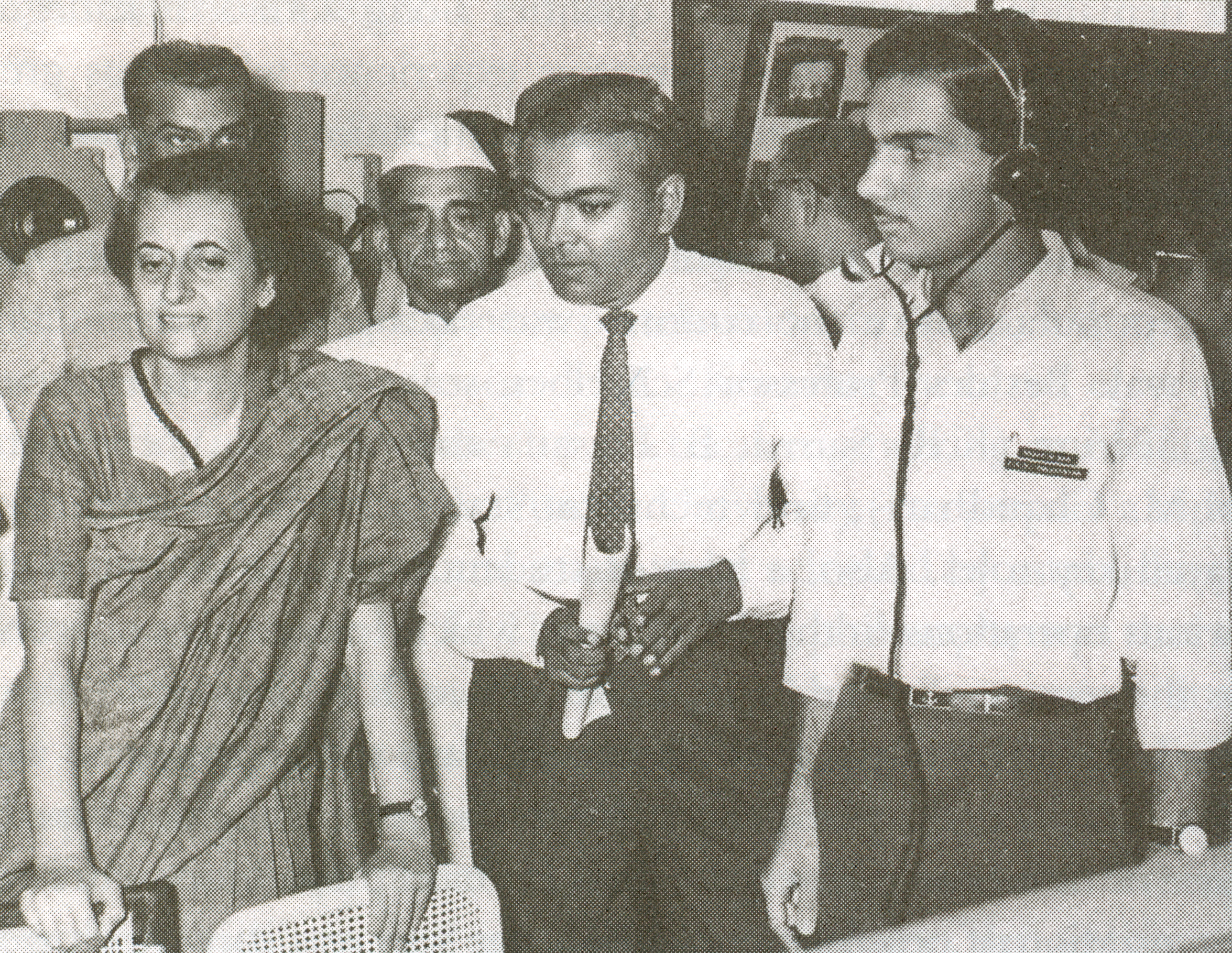
Mrs. Indira Gandhi on a tour of the IITK Television Centre with Prof. H.K. Kesavan, 1966. From An Eye for Excellence: First Fifty Innovative years of IIT Kanpur, page 276. Call it our imagination, but we see a bit of wistfulness in her expression, as if she is thinking - Wish I could play with these toys too!
Opening Windows!
Thank you for sharing the campus magazine. I do read the Spark regularly. In one of the issues there is the history of the first computer at IITK. It was very fascinating to read and find that it was the IBM-1620!
I really appreciate your acknowledging our contribution to the CSE Department endowment. But a small correction: My degree was in Comp Science not in EE. I was in the second batch to be given the M Tech in CS Degree.

Rao Remala
M.Tech, CSE, 1974
Lead
Developer, Microsoft Windows, Version 1
Thankyou, Rao. Our apologies for the error in the write-up. We have updated the online versions saved at the DORA site with the correction. Meanwhile, we thought we would share some of your
pioneering work with our readers, even more so the generation that has no idea what a ‘floppy disk’ looked like!
Picture Credit: This image of the Windows Version 0.01 demonstration disk is an internet download.
157
A Letter from a Former Member of the Spark
Just seeing the masthead brings back a slew of memories from the old days. Spark was not just a campus magazine we wrote for; it was a way of life. The first exhilarating meeting with the Spark members stands out, particularly. It was 1975 and we were a small group of 1st year kids, and it may have been all of a month or so since we had arrived on campus. The meeting was in Hall 1, just after dinner. We crowded into one of the rooms and listened to the seniors joke around and tell us what joining the Spark would entail. I remember being a little awed and totally thrilled by their various personalities. There was Chutki, the Editor (D. Roy), Suda, Keshavan, AD... all of them attractive and enthusiastic people, and I wanted so much to be part of the group.
After the meeting we came back to where we'd left our bikes. (Aside: we were a little group of three from the Girls Hostel, which was on the furthest end of the campus, just this side of the moat where the alligators would be if it had been mediaeval times) *. But there was nary a bike to be seen, although we hunted about. The lofty seniors came to lend a hand as well, and finally somebody spotted the bikes. They were above our heads, hanging from a tree next to the building, at second floor level, and I don't know if the jokesters were ever identified. Now's the time to speak up, if anyone knows!
Anyway, I joined up, and for 5 years, Spark was part of my IITK -- my memories include interviewing artists who came to the campus, hanging out at the printer's (with a precious copy of the masthead, carved in wood I seem to recall), going around hawking issues for 50 paise, covering the Cultural Fest and writing the daily bulletin that would be distributed hot off the presses. Towards the end, the Spark was flickering out. Times had changed. I kept a few copies in a trunk, for old times’ sake, and they must still be in there. I'm very happy the time has come for the Spark to make its comeback. All my affection and best wishes to the current team!
Anuradha
Jagannathan
MSc
Physics, 1975-80
Currently
Professor of Physics, Université Paris-Saclay
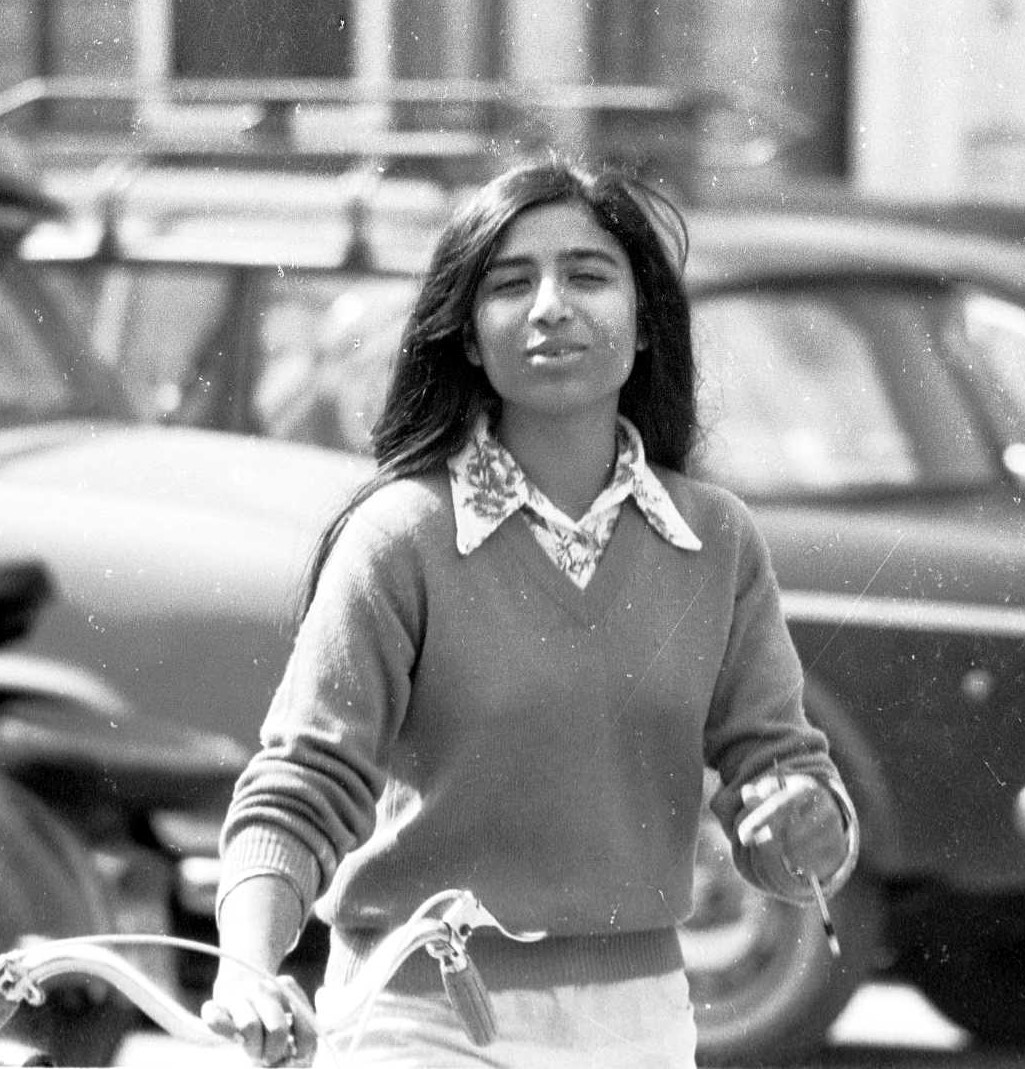
A branch of the Panki Canal, flowing
through the campus, and ending as a swampy wetland, separated the old
Girls Hostel from Halls I-V in those days. It had no crocodiles but
was home to plenty of snakes.
It's wonderful to hear from you, Anuradha!
You
were among the most in-tune girls on campus. Open, approachable, (and
well-adjusted to the skewed M-F ratio which made it very difficult
for the girls in the GH to lead a normal life).
We
hope and look forward to getting you back into the Spark loop.
Picture
Credit: Anuradha and her bike… Happily, reunited! Clicked by Shirish Joshi, 1977
158
Thank You!
In continuation to the previous three issues, thanks for developing and sending a soft copy of the fourth issue of SPARK. Along with a proper device, it is very much like reading the hard copy in the library.
As a Civil Engineer, I enjoyed reading the article on the new construction and comparing the soil properties and the seismic activity zones for Kanpur and Pilani (my present home). As per latest norms construction add-on on campus is more than safe even with those many storey buildings.
I look forward to the future issues of the Spark.
Kamalesh Kumar
B.Tech.
CE, 1986-90
Dept
of Civil Engineering, BITS Pilani
Congratulations to the Spark team for bringing out yet another wonderful issue of this magazine. I was alerted to the Spark issue by my classmate Dr. K. Ekanadham. Thanks to the Facebook post I was able to download and read Prof. Biswas’s earlier article on the History of Primes is in P.
Once again congratulations to the entire team.
Mukkai
Krishnamoorthy
MT/PhD,
EE, 1969-76
Faculty,
EE/CSE, 1976-79
Best Astronomy Photographer of the Year 2022
It gives us immense pleasure to share with you that Soumyadeep Mukherjee, a PhD student in the Department of Humanities and Social Sciences, has been selected as the Winner of the Astronomy Photographer of the Year 2022. In an award ceremony held at the Royal Observatory, Greenwich, his image "A Year in the Sun" has been awarded the first prize for the category "Our Sun". This makes him the first person from India to have won in any of the main categories in the history of this competition.The image will be published in the official yearbook of the competition and will be exhibited at Royal Museums, Greenwich.
Soumyadeep has been practising astrophotography for the last two years. He has over 50 publications in international books and magazines, including Astronomy, BBC Sky at Night, Sky and Telescope etc. His images have appeared multiple times in NASA, National Geographic, Space.com, Spaceweather, Earthsky, Forbes, etc. Last year, two of his images were selected as finalists for the Astronomy Photographer of the Year (2021) for the Best Newcomer category and the People's Choice Award.
We wish him the best in all of his future endeavours.
Nitin
Kumar
BSc
Physics, 2020-24,
Coordinator,
Photography Club
159
A Year in the Sun
I imaged the Sun for 365 days between 25 December 2020 and 31 December 2021, missing just six days during this period. The project started with the aim of recording the journey of a single sunspot across the solar disc, but I managed to continue it for a year.
I blended the images to create a single shot, which records the rise of Solar Cycle 25. A total of 127 active regions appeared on the Earth-facing solar disc (AR 12794–AR 12921) during this phase and the image shows all of them. The sunspots create two bands on the solar disc, around 15–35 degrees north and south of the equator and gradually start drifting towards it – a phenomenon known as Spörer’s law.

Equipment used: Nikon D5600 camera, Sigma 150–600c lens,Thousand Oaks Filter (White-Light), 600 mm f/6.3, ISO 100, 365 individual exposures (1/80-second to 1/500-second). Image taken in Kolkata, West Bengal, India
Soumyadeep Mukherjee
Research
Scholar, HSS, IIT Kanpur
160
Remembering Professor H N Mahabala

Prof. H N Mahabala, one of the pioneers of IT education in India, passed away on June 27, 2022, at his residence in Bangalore. Professor Mahabala had joined the IIT Kanpur EE Department in early 1965 from the University of Waterloo. Earlier, he had worked with a Bendix computer at the University of Saskatchewan in Canada where he had obtained a Ph.D. in August 1964.
At IITK, he along with Professor Rajaraman, played a crucial role in developing the earliest Computer Science courses in India. In 1965 Professors Mahabala and Rajaraman started teaching courses in CS and then requested Professor Kesavan (then HOD, EE) to allow them to introduce an option in MTech EE with specialisation in Computer Science. Students from those early batches recall how they were fortunate to be taught by both Professors M and R. While Prof M taught Mentor (a pseudo machine language) and Fortran II on the IBM 1620, Prof R taught Analog Computer programming, making these classes so easy to understand.
In 1973 Prof. Mahabala moved to IIT Madras, where he established the IITM Computer Centre. He remained at IITM till his retirement in 1995. Post retirement, he continued to influence technology policy in India during his tenure as President of the Computer Society of India (CSI).
Prof Mahabala played a leading role in developing the Indian Infotech sector, and is fondly remembered by his peers, colleagues and students for his vision, insight, and inspiration. Among his students were Narayana Murthy (at IIT Kanpur) and another Infosys co-founder Kris Balakrishnan (at IIT Madras).
In this tribute, we share some pictures received from the former CSE faculty members of IITK.
161
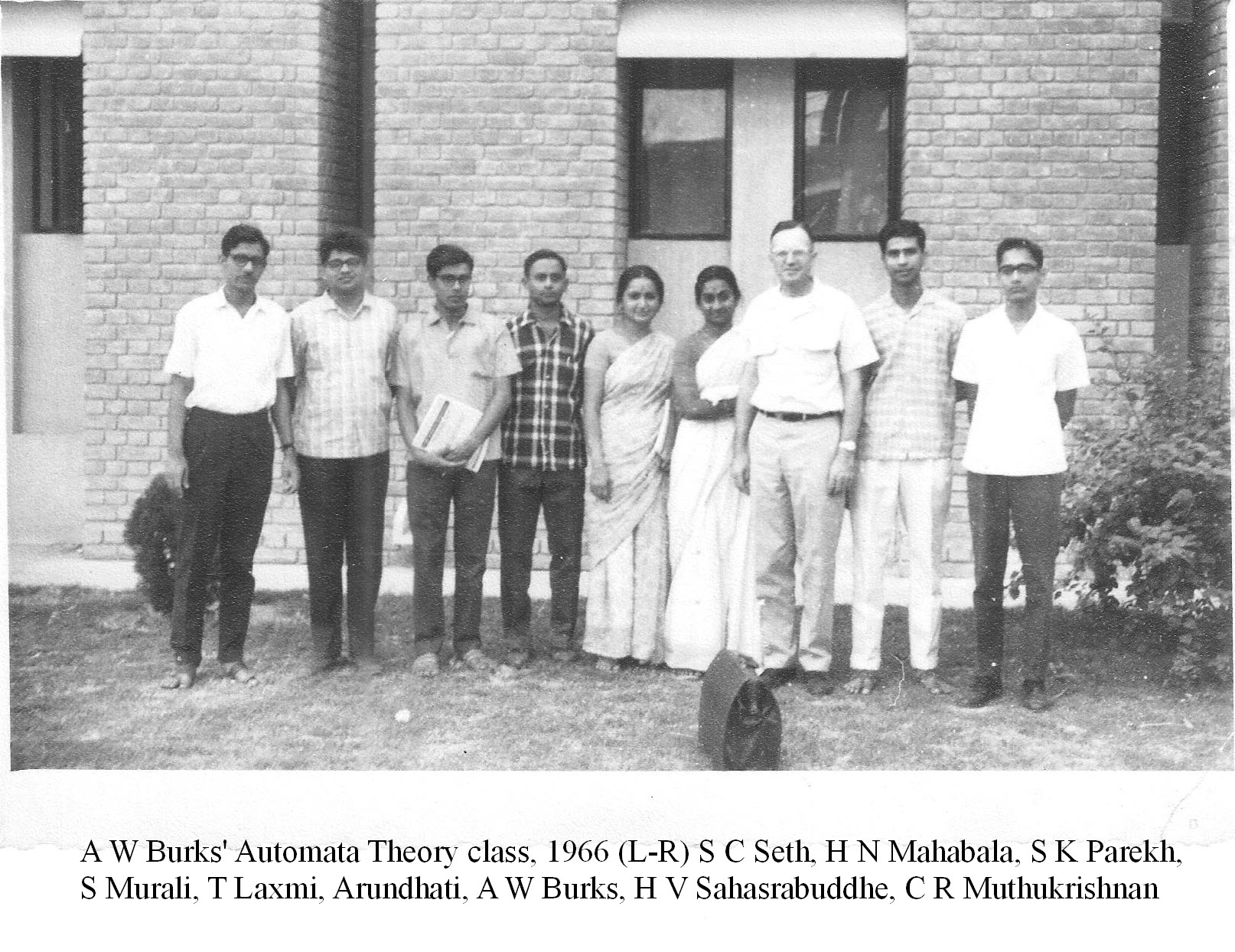
Professor Arthur W Burks, Univ. of Michigan, and one of the principal designers of ENIAC and the von Neumann architecture, was a visiting professor at IITK from 1965-67. During this period, he taught classes in Automata Theory to IITK students. This picture has been shared by Prof H V Sahasrabuddhe.
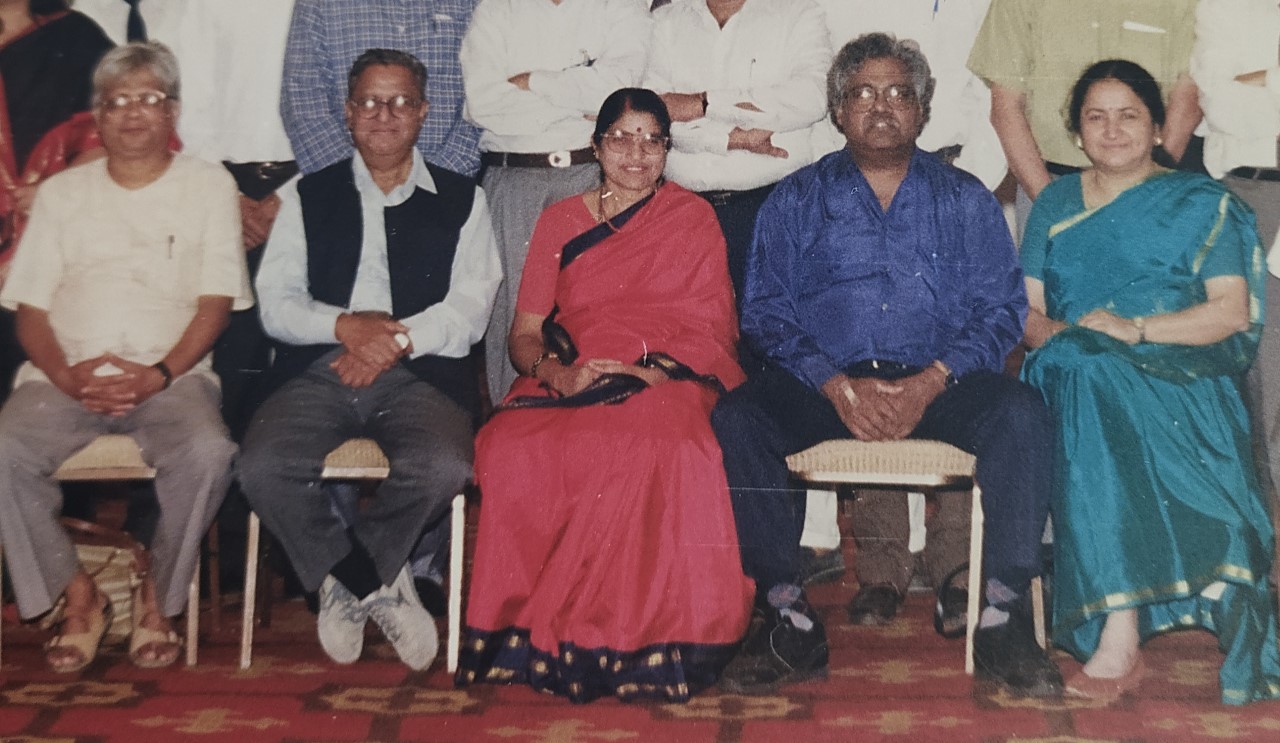
A group picture taken at Prof Rajaraman’s retirement celebration in 1994 shows (L to R) Prof. Mahabala, Prof. and Mrs. Rajaraman, and Professors T. R. and T. Lakshmi Viswanathan. Picture shared by Professors Rajaraman and Viswanathan.
162
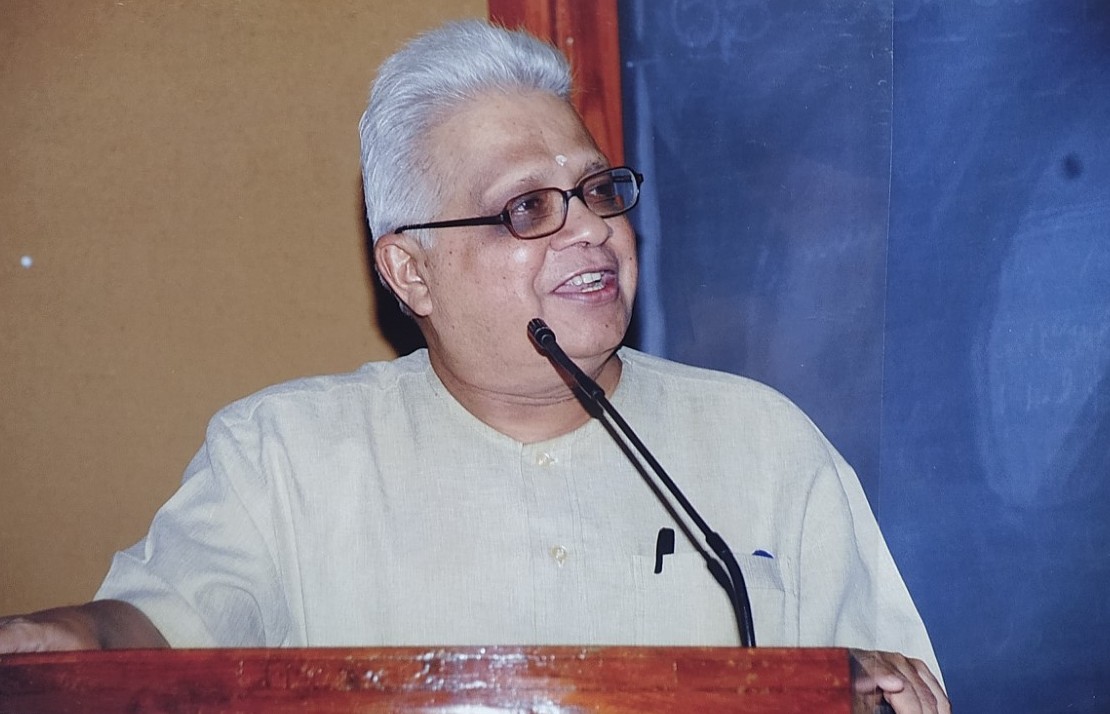
Speakingat Prof Rajaraman’s 75 birthday celebration, 2009. Picture shared by Prof V. Rajaraman.
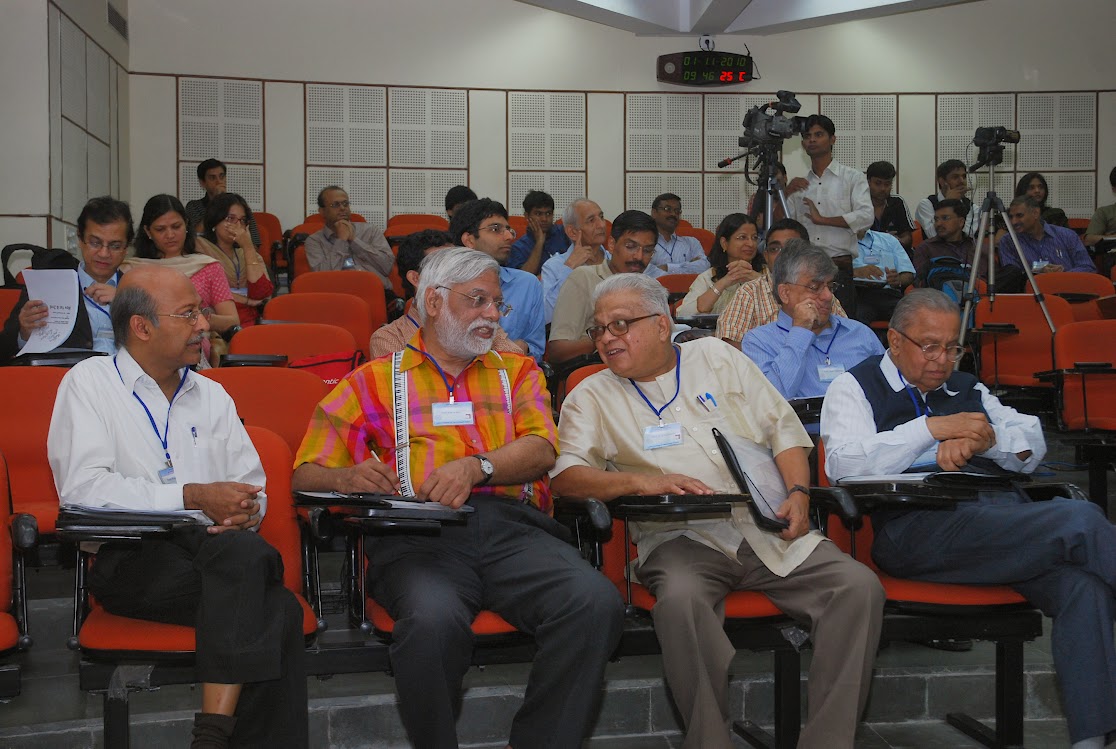
A
candid moment with Prof. Kesav Nori at the IITK Golden Jubilee
celebration, 2010. Also visible are Professors Rajiv Sangal on the
left and Prof V. Rajaraman on the right. Picture is from the IITK
CSE Archives.
Special thanks
to Prof T. R. Viswanathan for collecting these pictures and sharing
them with us.
163
A Journey to Saskatoon
I had lived with Prof. Mahabala during our days at IISc, Universities of Saskatchewan and Waterloo, and finally at IIT Kanpur, virtually as his younger brother. My association with him started in 1956 when I started my new elite education at the Indian Institute of Science, Bangalore. We became friends instantaneously and remained that way for life. I spent more time with him than anyone in my own family.
After graduating in ECE, both of us started our first jobs as instructors at IISc with part-time research work as graduate students. A predecessor named Swamy had persuaded Mahabala to pursue PhD studies in Saskatchewan, Canada. I had admission and financial assistance as a TA in a well-known university in the US (Wisconsin) where another senior student named Rajaraman had completed his doctorate work, but Mahabala argued that I was better off going with him instead. His reasoning was that Canada was a better choice because we would be funded as RAs with tuition included (instead of TAs without tuition) and coursework would be lighter.
Mahabala’s parents were concerned about their only child sailing alone to London and New York (Yes, we went by ship, it was much less expensive!). I looked like a strong bodyguard for their child-like boy, so they talked me into going with him. My school-teacher parents were worried about funding sources for travel, but Mahabala had figured it all out, and we approached Tata’s endowment for loans to students going abroad. Mahabala also put me through a training routine so that I could pass the interview by Mrs. Vesugar, who managed the endowment: how to dress, eat with a knife and fork, and not appear on the deck of the British Ocean-liner in pyjamas.
We had the most memorable trip to London followed by a French-boat to cross the Atlantic. Mahabala had planned our en route visits to Cairo in Egypt, Naples in Italy, and Marseilles in France. More impressive was our stay in London for a week, before the connecting ride to New York from Tilbury docks. All in all, it was a 40-day trip including the bus ride from New York City to Niagara Falls and onwards by a long train journey to Saskatoon.
We rented a house and the three Indian students settled down to start the Fall semester at school. School was easy: it was an agricultural school concerned with teaching soil science and animal husbandry. There were many Catholic priests from Kerala and school teachers from Gujarat teaching English that sounded like Gujarati. There was another Indian who had MBBS from King’s College in London. So, the teacher, doctor and priest were from India. Now they also had graduate students from India and British professors.
It was an interesting and ideal place for Mahabala. He learned everything Canadian. We were vegetarians, yet he observed how they cooked meat, chicken and turkey. He taught Canadians how to make Bisibele-Hulianna. Mahabala was so talented that it is not easy for me to describe his qualities. He could not tolerate mediocrity. On the other hand, he was enthusiastic about helping students. He treated me as his younger brother, and he was a source of inspiration for me. I have been deeply saddened by his demise.
T
R Viswanathan
Professor,
EE/CSE, IITK, 1965-78
Professor
Emeritus, EE/CE, Univ of Texas, Austin; Silicon Laboratories Endowed
Chair, 2007-2020
164
The IITK CSE Department in the 21st Century
The beginning of the 21st century saw the IITK CSE Department achieve new heights as International recognition followed the discovery of the Primality Test on campus.
Concurrently, IITK students kept the institute banner flying through their individual achievements. Karan Malhotra, a first-year B.Tech. (EE) student, was chosen as the Indian recipient of the prestigious Lucent Scholarship in 2003; the very next year, Cherian Varkey Mathew, a first-year B.Tech (CSE) student, was chosen as the 2004 recipient. These students got the opportunity to spend time at Bell Labs in New Jersey, interacting with several Nobel Laureates.
The CSE Department was involved in several projects of national significance supported by the Government. Bringing the benefits of information and communication design technologies to farmers and traders of agricultural commodities in the region, the Kanpur- Lucknow hub of Media Lab Asia established a “Digital Mandi'' and an experimental wireless VOIP phone based PCO extension counter at a nearby village. Technology developed at IITK’s Resource Centre for Indian Languages was transferred to eight centres for machine aided translation from English to Oriya, Bengali, Marathi, Assamese, Manipuri, Konkani, Urdu, Punjabi, Malayalam and Sanskrit. Software code compliance tools and software test coverage analysers developed within the CSE Department were commercialised by the Centre for Reliability, Chennai, a laboratory of the Ministry of Communication and Information Technology.

International recognition of the discovery of the AKS Primality Test continued when Dr. Manindra Agrawal and his students Neeraj Kayal and Nitin Saxena (who continued to pursue PhDs at IITK) were awarded the 2006 Gödel Prize for their paper "PRIMES is in P”. This award is given jointly by the European Association for Theoretical Computer Science (EATCS) and the Association for Computing Machinery Special Interest Group on Algorithms and Computational Theory (ACM). They also received the 2006 Fulkerson Prize, awarded jointly by the American Mathematical Society and the Mathematical Optimization Society.
During the academic year 2006-07, IITK received a grant of Rs. 4 crores from TCS for establishing a Foundation for Research in Algorithms on campus, supporting both pure and applied research. The Foundation organised several workshops in different areas of algorithms and also supported research visits to IITK as well as other institutions.
165
Golden Jubilee Celebrations
In August 2009, the Golden Jubilee celebration of IITK was inaugurated by alumnus N. R. Narayana Murthy, founder (and former CEO and Chairman) of Infosys. IITK organised several academic, cultural, and sports events throughout the year. The CSE Department celebrated with a special event that included professors who founded and grew the department in its early years. They, as well as recent leaders of the department, including Profs. Biswas and Agrawal, discussed the history and current status of the department. Panel discussions included the Changing Face of CSE Education, addressing new challenges and expectations. Attendees included alumni who provided their perspectives as professors in US universities. The event was marked by pleasant memories, nostalgia, a renewed sense of attachment, pride in the achievements of the past, and hopes for an ever-brighter future for the department and the institute.
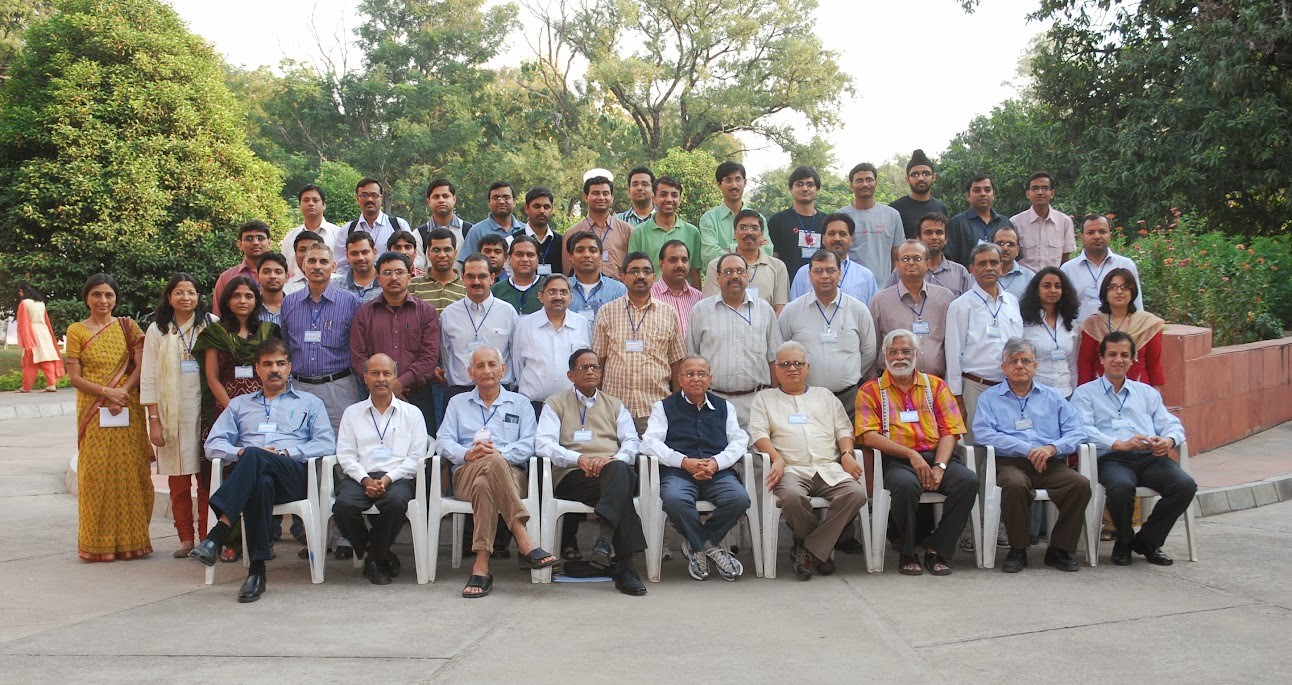
IITK CSE Golden Jubilee Reunion in 2010. Seated (L to R) are former Professors: Pankaj Jalote, Rajiv Sangal, PCP Bhatt, R Sankar, V Rajaraman, HN Mahabala, KV Nori, VK Vaishnavi, and Gautam Barua. Current faculty members (and alumni/students) are in the standing rows. Picture Credit: CSE Archives.
In 2010, the Ministry for Railways announced the success of a pilot project jointly developed by IIT Kanpur and RDSO (Research Design and Standards Organisation of the Indian Railways). The result was SIMRAN, a GPS-based Real Time Train Information System (RTIS) to provide reliable information on operative trains, inaugurated by the Minister of Railways in October 2011.
Digital Mandi for Indian Kisan, a unique web and mobile phone-based agriculture commodity price retrieval system was inaugurated in August 2011 by Mr. Kapil Sibal, the Minister of Communications and Information Technology and Minister of Human Resource Development (MHRD). This inexpensive multilingual subscription-based service provides SMS/voice alerts for registered farmers about prices of selected crops. The application was deployed on the BSNL national network, supporting millions of farmers.
166
High Performance Computing (HPC)
The Department of Science and Technology (DST) provided generous support to upgrade the institute’s HPC infrastructure to a state-of-the-art facility, supplied by Hewlett-Packard in June 2010. Upon its arrival, IITK found a spot in the global TOP 500 HPC list with its rank at 369 and became the best HPC facility, among all academic institutions in the country.
The HPC facility provided a major boost to our research in computational science and engineering. The Centre helped train a new generation of scientists and engineers in advanced computing, developed sharable application software for parallel platforms and motivated young minds to take up challenging problems in computation. The facility provided the much-needed opportunity to attempt Grand Challenge problems in science and engineering, such as computational fluid dynamics, environmental modelling, molecular modelling of chemical processes, and biomechanics.
The success of the first HPC project allowed the Institute to significantly upgrade its HPC facility by procuring a high-end supercomputer in 2013. HPC2013 was ranked 119 in the global Top500 List of June 2014, it was 5th in India and the fastest among educational institutions of India. It had a theoretical peak performance of 307.2 Teraflops. The HPC cluster consisted of 8 management nodes, 781 computer nodes, 500TB storage and FDR InfiniBand interconnect. A modern data centre with state-of-the-art precision air conditioning and fire safety features was built in the central area of the Computer Centre.

The HPC 2013 facility. Picture is from the IITK archives.
Computational Research
During the year 2013-14, a new Advanced Centre for Computational Research and Education was started under the FAST program of MHRD for a period of five years, leading to high quality research and manpower development. In addition, the Centre had a visitors’ program and organised short term courses involving researchers from different engineering departments including aerospace, mechanical, chemical, biological sciences and engineering, and chemistry.
The Rajeev Motwani Building
In 2010, on the 49th birthday of the late alumnus Rajeev Motwani, the Institute received a donation for US $1.5 million from the Rajeev Motwani Foundation for construction of a new CSE Building; Mrs. Asha Jadeja donated additional amounts over the coming years. The project was initiated, and construction work started in early May 2011. When inaugurated on December 19, 2014, the building was a six-story structure with a floor area of 3,650 square metres and included a 200-seat classroom, 22 faculty offices and 17 labs. It was designed by the architectural firm of Kanvinde, Rai and Chowdhury who had also designed the original IITK campus.
167
The Building housed activities of the Department of Computer Science and Engineering, along with activities for nurturing entrepreneurship and innovation in the areas influenced by Rajeev's work. The donation marked the start of collaboration between the Rajeev Motwani Foundation and IIT Kanpur to help student and faculty entrepreneurs collaborate on transforming innovative ideas and technologies into successful enterprises.
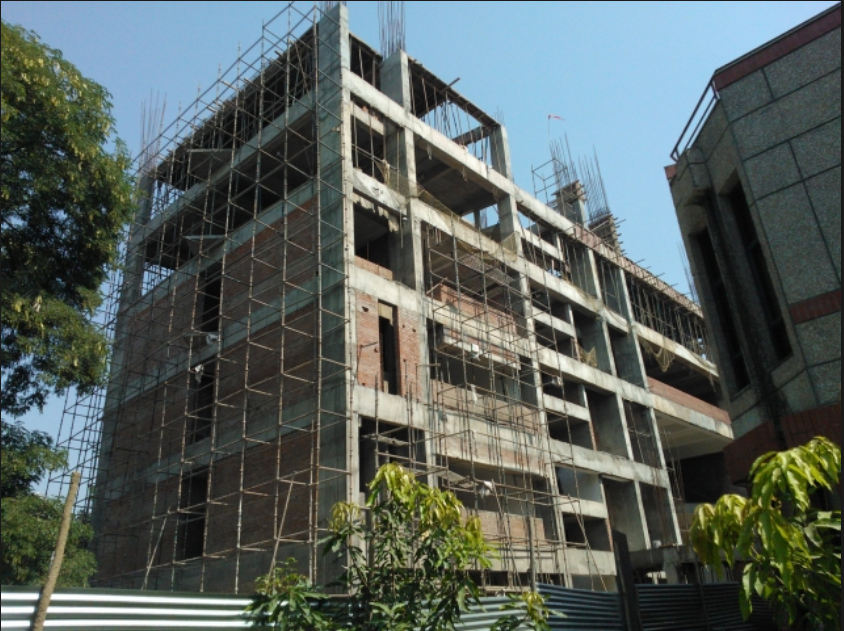
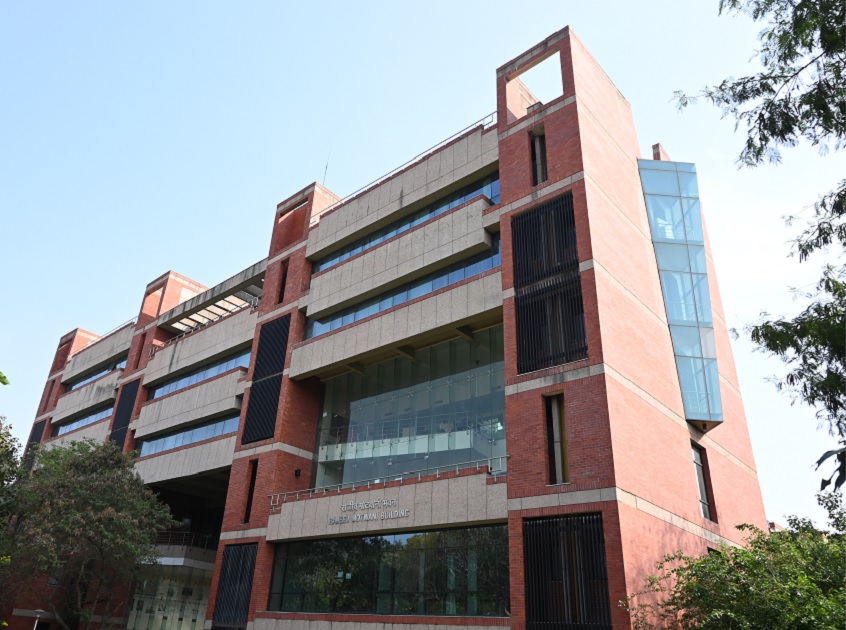
The Rajeev Motwani building. (L) Under Construction, May 2012, and (R) in 2022. 2022 Picture Credit: Girish Pant (Information Cell, IITK)
Entrepreneurship
The PRIME83 Fund was a gift to IITK from the class of 1978-83 and was set up to “Promote Research, Innovation, Mentoring and Entrepreneurship” at IITK. Rajeev Motwani and his foundation became seed contributors by donating some of his founder’s shares of Google. Over time this fund has supported over 20 companies including Nocca Robotics, ProSoc, AirBirdz, and about 100 other entrepreneurs. Nocca Robotics went on to build India’s first ventilators saving thousands of lives during the Covid Pandemic. Another company, AIPL received seed-funding from PRIME83 to design and fabricate Oxygen generation plants for rural hospitals in order to meet critical supply needs during the Summer of 2021.
Educational Innovation
With the growing popularity of Massively Open Online Courses (MOOCs), the problem of automating components of education was the need of the hour. In 2012, IITK CSE developed Intelligent Tutoring Systems for high school students. Automated tutoring systems were developed for topics such as the Periodic Table, Limits, Trigonometry, Natural Deduction, and Visual Sequences. These tutoring systems helped instructors in creating sample solutions for assignment problems, new problems along with solutions, and variants of seed problems. This project was accomplished in collaboration with Microsoft Research, and showcased at Techfest 2013, at their headquarters in Redmond, Washington, USA.
In 2015 the Ministry of Communication and Information Technology (MCIT) funded a major project focusing on the development and delivery of a high technology platform using state of the art mechanisms for delivery of courses in Information and Communication Technology. The platform built upon, improved and scaled existing technological platforms in the education domain, already developed and tested at IIT Kanpur like intelligent tutor and mini-MOOC platforms for capacity building of sixteen thousand faculty members across four states of Uttar Pradesh, Haryana, Delhi and Chandigarh.
168
Cyber-Defense of Infrastructure
During the academic year 2016-17, a project titled National Interdisciplinary Centre for Cyber-Security and Cyber-Defense of Critical Infrastructures was sanctioned by the Science and Engineering Research Board (SERB). This project addresses the defence of critical infrastructure such as power grid, water and sewage system, railway signalling and transportation, manufacturing and process control. which are vulnerable to cyber-attacks. The new centre received funding of Rs.14.43 crore from SERB/DST to build India's first industry scale cyber-security testbed for cyber-physical infrastructure, and to carry out research on protection, detection, and cyber-attack resilient design of critical infrastructure projects.
Modelling COVID
The outbreak of the COVID pandemic brought the world to a standstill in 2020, disrupting lifestyles which are only now beginning to return to normal. After analysing the real-time infection data on the pandemic for nine nations, IITK researchers identified daily infection count and number of infected individuals as the key parameters. It was envisaged that the long-term community transmission may be inducing power law growth of the epidemic.
The project titled Optimization of Lockdown, Testing & Isolating Strategies to contain COVID-19 in India was granted by SERB under its call on Mathematical Modelling and Computations (MATRICS) for COVID19 Infections. The objective of the project was the optimization of strategies related to lockdown period, successful testing and isolating. The resulting model, called SUTRA, captured the trajectories of coronavirus transmission across the world, successfully addressing two challenges faced by existing models: interventions made by governments as well as the non-detection of the infection of numerous asymptomatic patients.
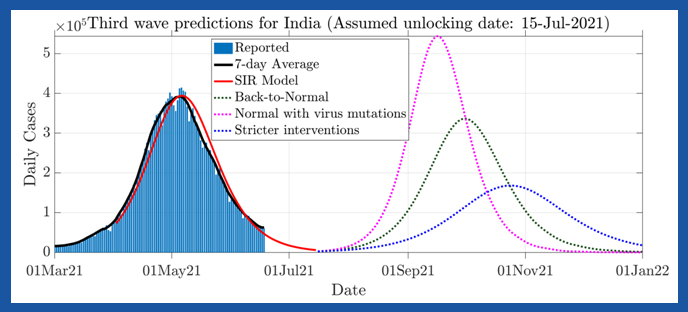
Cyber-Security Hub (C3ihub)
In 2020, the C3ihub was created at IITK under the DST’s National Mission of Interdisciplinary Cyber-Physical Systems (NM-ICPS), to address security of cyber-physical systems: analysing security vulnerabilities, developing tools to addressing them at various levels of system architecture, translating these tools to deployment ready software, nucleating start-ups developing these tools at scale, partnering with industries in this domain for co-development and transfer of these technologies, and training the next generation of cyber security professionals. C3ihub supports security research and development at several institutions, with three collaborating partners already on board (IISc Bangalore, IIT Kharagpur, and IIITA Prayagraj). Industry partners will assist in understanding practical needs, productization of the developed tools, and to provide services based on the methodologies and standards developed.
169
Param Sanganak High Performance Computing Cluster
Param Sanganak is a state-of-the-art, 100% direct liquid cooled (DLC) supercomputer, part of the National Supercomputing Mission to attain self-reliance in supercomputing, installed at IITK campus in 2020. The system addresses research needs of domains such as Weather & Climate, Oil & Gas, Seismic, Life, and Materials Sciences. The system was built with cutting-edge hardware and software technologies, with total peak performance of 1.6 Petaflops. Critical components such as motherboards for servers are manufactured in India, and the servers are assembled, validated, and tested in India. The rack power controllers, rack hydraulic controllers, and the adiabatic dry coolers provided with the supercomputer for warm water cooling of the system are also manufactured in India.
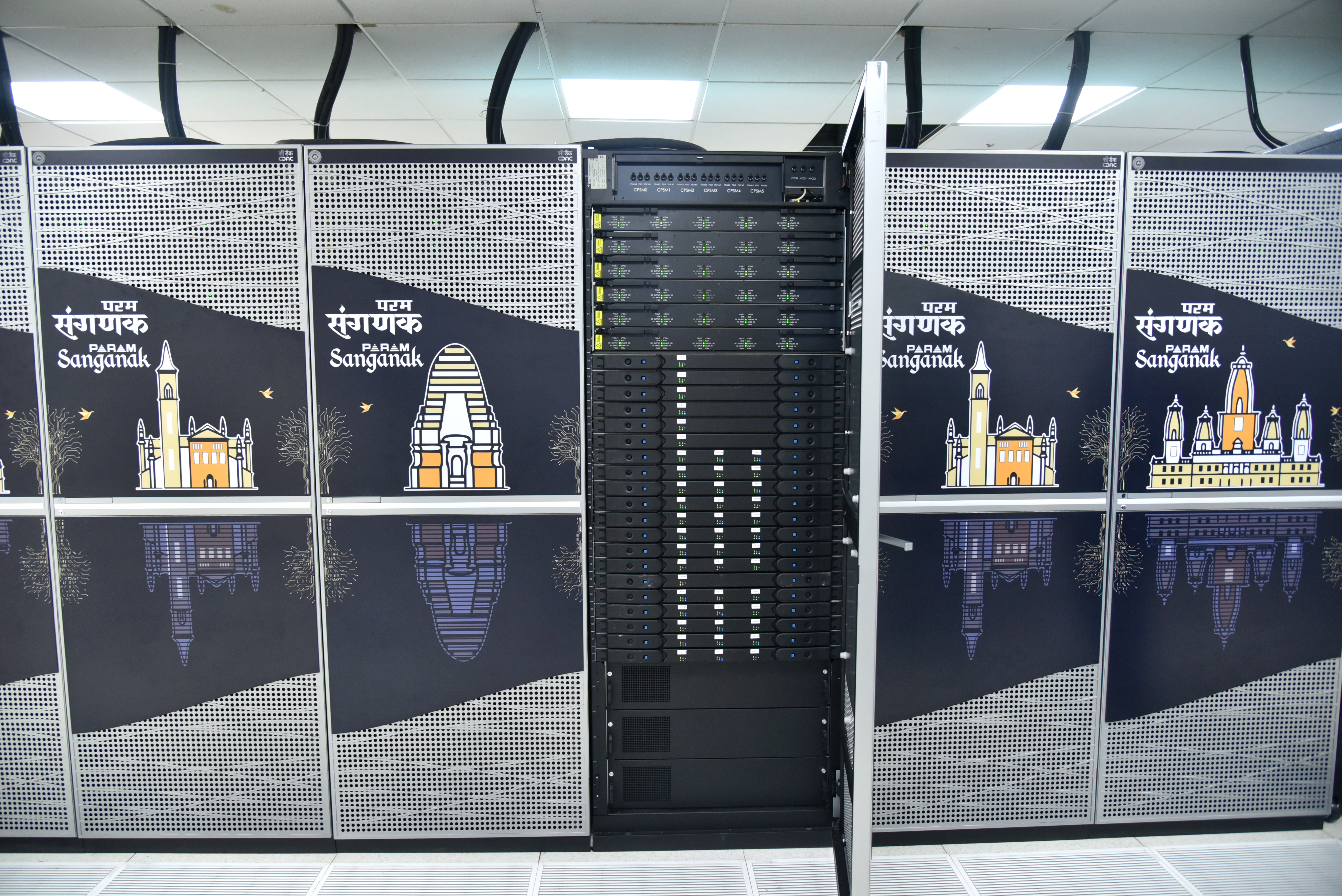
The Param Sanganak at IITK, 2021. Picture Credit: Girish Pant (Information Cell, IITK)
The Gita Supersite
In 2020 IITK developed a website to create a multilingual repository of Indian religious texts on the Internet, and to make these freely available to whoever is interested. The original site, which included multiple commentaries and translations of the Bhagavad-Gita, is being extended to include the Upanishads and other works. The texts are in Sanskrit and can be viewed in any of 11 language scripts: Assamese, Bengali, Devanagari, Gujarati, Kannada, Malayalam, Oriya, Punjabi, Roman, Tamil and Telugu.
The E-Passport
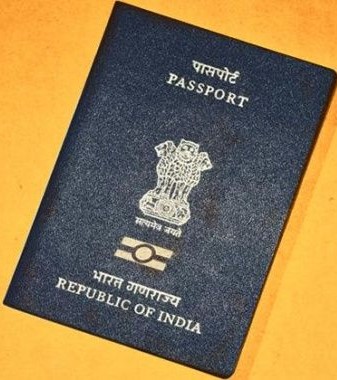
IITK, in association with the National Informatics Centre has developed a new infrastructure supporting the government's ambitious e-passport service, employing the technology used by plastic smart cards. This technology relies on SCOSTA-CL, a software standard for smart card operating systems that supports secure messaging, developed at IITK under the leadership of Prof. Rajat Moona (currently Director IIT Gandhinagar). About 4 KB to 150 KB data can be stored on a smart card chip, and the operating system provides an access control protocol. The SCOSTA-CL standard is compliant with international standards for reading passports and defines the standard of interoperability even while personalising passports in offices across the country and missions abroad. This permits the inlays with embedded chip and antenna to be procured by the manufacturers across the world. According to the External Affairs Minister S. Jaishankar, India is expected to begin rollout of e-Passports at the end of 2022.
170
The Path Ahead
The CSE Department has come a long way over the past twenty years. Both students and faculty have grown substantially, necessitating a larger variety of courses, including many that have been newly designed. Currently there are about 450 BTech students, 40 five-year BS/MS students, 210 MTech students, and 110 PhD students. Also, thanks to the ever-growing reach, and pervasive nature of computer science over this period; a large number of students from other disciplines also take CSE courses.
Currently, the CSE Department has 31 faculty members, half of whom are junior faculty members with many new areas of technical expertise; the department also hosts 8 post-doctoral fellows and 5 visiting faculty members. They are ably supported by 16 technical and administrative staff members. Historically, the strength of the department has been Theoretical Computer Science and a few subareas of Systems. Today, the reputation of the theory group remains strong. Moreover, the new hires in the last six years have ensured growing strength in other areas: Computer Architecture, Compilers, Languages, Formal Methods, Data Mining, Operating Systems, Cyber Security, Hardware Security, Cyber Physical Systems, High Performance Computing, Networks, Machine Learning, Natural Language Processing, Computational Biology, Computational Cognitive Science, Visual Computing, Embedded Computing, Internet-of-Things (IoT) devices. The researchers in these new areas have been publishing in premier venues and winning awards globally. About a hundred prestigious conference papers have been published each year by faculty members, with a large majority in AI and associated research areas.
Alumni continue to play a significant role in supporting the Department. In 2021, the class of 1997 instituted the Tapas Mishra memorial chair to remember a batchmate and dear friend who passed away at an early age. In 2022, alumni from the batches of the 1960s and 70s collaborated to establish the Prof. T R Viswanathan chair to honour faculty who distinguish themselves in teaching and create a positive influence in the lives of students by mentoring them.
The IITK Computer Science program has played a pioneering role in India, with numerous achievements. This has been due to the efforts of actively engaged faculty, visionary leadership, enthusiastic student community, and an environment that encourages open discussion and innovation. The CSE department has kept up with the global changes in research emphases in the field, with internationally recognized research results, while also addressing applications of high significance in the Indian context. IITK CSE alumni have been recognized for the important roles they have taken up nationally and globally, in academia and industry. Today, the department is stronger, more confident and proactive, and we expect even more growth in the near future. The fulfilment of high expectations for the department will depend on success in continued recruitment of faculty committed to excellence in research and education, as well as students focused on learning and academic achievements.
Compiled by the Editors of the Spark using information sourced from the IITK Annual Reports, with thanks to Professor Nitin Saxena for his inputs.
171
Flex-E Centre: Intersecting Engineering, Research, and Entrepreneurship
Vox Populi, September 2022
Early on, at the start of the millennium, Mr. Satish Kaura, an alumnus of our institute, was running a business that manufactured most of the cathode ray tubes for displays used in the country. He had the foresight to realise that the industry would need to be nimble, and change and evolve in the coming years. The inception of the Flexible Electronics ecosystem at IIT Kanpur was set in motion with the Samtel Centre for Display Technologies coming up under the guidance of Professors K. R. Sarma and R. Sharan and a team of enthusiastic faculty members from several departments of the institute.
While this facilitated and enhanced academia-industry collaboration, there were still challenges faced in translating the research ideas into manufacturing and making them commercially viable. The National Centre for Flexible Electronics (Flex-E Centre), built as a Centre of Excellence, came about to address this need. The Flex-E Centre is home to the intersection of industrial ideation, manufacturing and entrepreneurial ventures engaging with corporate pioneers and academicians, along with the support of the Ministry of Electronics and Information Technology (MeitY) of the Government of India and the Institute administration. With more than 20 member industries, and NDAs with over 125 organisations, the Flex-E Centre stands tall in the academic area as a place of innovation and science. To cover the activities at this centre, correspondents from Vox Populi reached out to Prof. Sundar Kumar Iyer, the current coordinator, and visited the facility to get a glimpse of its day-to-day happenings.

Professor Sundar Kumar Iyer explaining concepts of flexible and printable electronics
Projects
The Flex-E Centre building is a state-of-the-art facility that is home to more than 10 ongoing projects spanning various industries. The core group leading this centre consists of faculty members who are mentors, a chief operating officer (COO) and subject expert team leaders. They are supported by several research, maintenance, and office staff. Many of the researchers involved with the centre have national and international experience. Currently, the activities in the facility are funded by MeitY, the strategic sector (e.g. Indian Space Research Organisation (ISRO) and the Defence Research and Development Organisation (DRDO)), and industrial partners. The annual operational costs for the centre are about Rs. 8 – 10 crores.
172
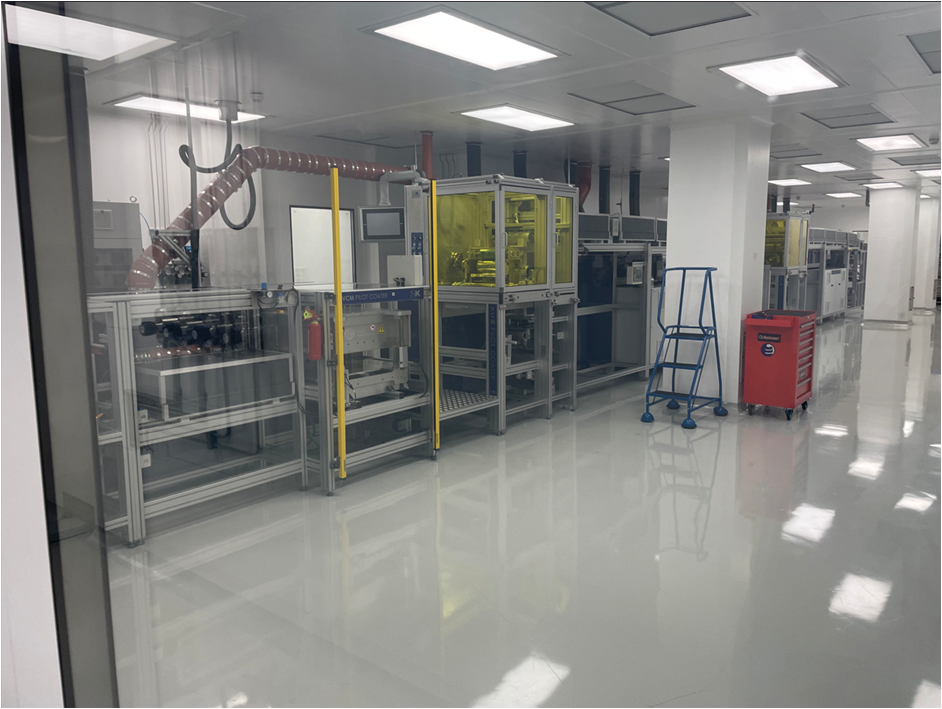
VCM pilot coater: A roll-to-roll based printer at the FlexE centre
Support Labs
The lab has many tools to facilitate its work, including circuit magnifiers, equipment to integrate chips on printed circuit boards, a 3D printer, circuit testing equipment and the like. We visited the support labs, starting with the Wet Lab, where inks are developed for printing electronics on various flexible substrates such as plastics, paper, cloth, and metal foils. The in-house facility also develops inks, often custom built on request of partner industries, as well as for ongoing projects. These inks along with some commercially available inks provide the basic building blocks for flexible and printed electronic products.
At the other end of prototype and product development is the Systems Lab. Here the printed components are given a useful practical product form, often in conjunction with traditional electronics and already available components. In this lab, we saw some novel applications developed by the centre that addressed some common problems faced in society. The various flexible electronic components developed are tested and refined in the other labs – the Electrical Lab, Optics Lab, Materials Lab, and Sensors Lab.
Products
We saw some of the products developed at the centre by the different groups. The problems that the products address are practical and often typically Indian in their context.
One such product which is built upon investigative research carried out earlier at IIT Kanpur, is about verifying milk quality (Prof. Siddhartha Panda, Dr Devendra Mourya and team). In India, milk is often procured by cooperatives from multiple sources. Contamination from any one source can contaminate the whole collection. This project aims to develop a product that can detect many of the common contaminants quickly, effectively and at a low cost so that contaminated milk may be identified before it is accepted.
We also viewed some innovative applications in healthcare developed at the centre. Prof. Mazhari, Mr Biswanath Panda and the team have developed a few versions of temperature monitoring devices that were deployed during the pandemic within our institute. Another innovation by this team is detecting the level of liquid in intravenous (IV) fluid bottles used in medical facilities. This innovation can alert the nurse (electronically or by an alarm) when the level of the liquid comes close to ending. The innovative labels used for this prototype were built with in-house ink and printed in the roll-to-roll machine. This product when deployed will aid in taking the stress of caregivers who will no longer have to worry about the IV feed running empty.
173
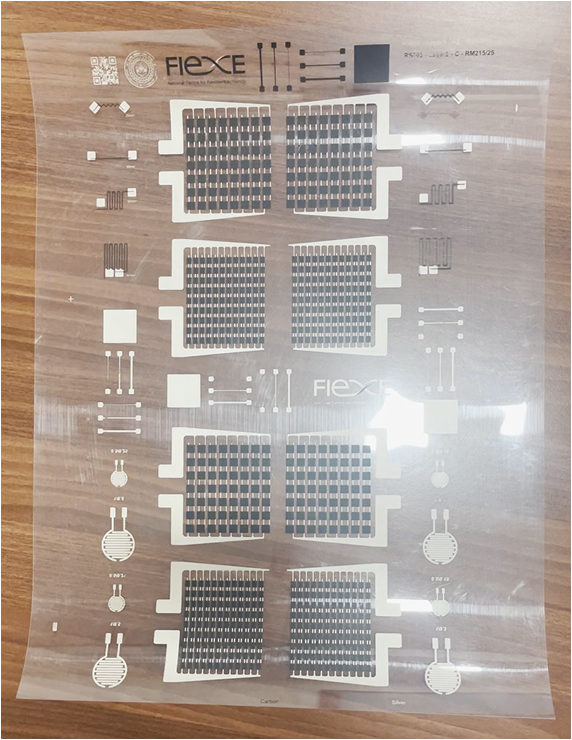
A heater circuit, printed at the facility on a flexible plastic substrate
Warm Hug is a product developed by multiple teams at the centre. For this product, heaters are printed with in-house developed carbon inks and then integrated into jackets. The heaters are self-limiting at the maximum temperature they can reach and thus are safe for regular use. These jackets are primarily being developed to assist soldiers stationed at higher altitudes to stay warm while using minimal portable electrical power, roughly equivalent to what we store in our phone batteries, to warm up the jacket. The initial prototypes were tried out by SIS guards at our campus in the Kanpur winters. The Defence Forces have been in talks with Flex-E Centre to test and assess deployment in higher altitudes.
Another area of innovation is flexible displays and lighting with organic light-emitting diode (OLED) technology. Prof. Monica Katiyar, Dr Muralidharan Balasubramanian and the team are exploring a variety of applications, including some in the automobile sector. Prof. Deepak Gupta, Dr Ashutosh Tripathi and the team are involved in many innovative projects with DRDO and ISRO using thin film transistor (TFT) technology and other devices for deployment in submarines and antennas respectively. Prof. Anshu Gaur is looking into using amorphous metal-oxide and metal-oxynitride semiconductors to build flexible electronic devices. Prof. Iyer’s team is developing flexible solar modules on paper substrates.
The Flex-E Centre has spawned a couple of start-up ventures. One such start-up is Checko from Prof. Deepak Gupta’s team, which prints PUFs (Physically Unclonable Features). The unique ID of the PUF can be verified for authenticity by using a pre-downloaded app on a smartphone. The product is currently used by Madhya Pradesh Beej Nigam and the Delhi Excise Department, in addition to many private companies that want to ensure their brand protection.
174
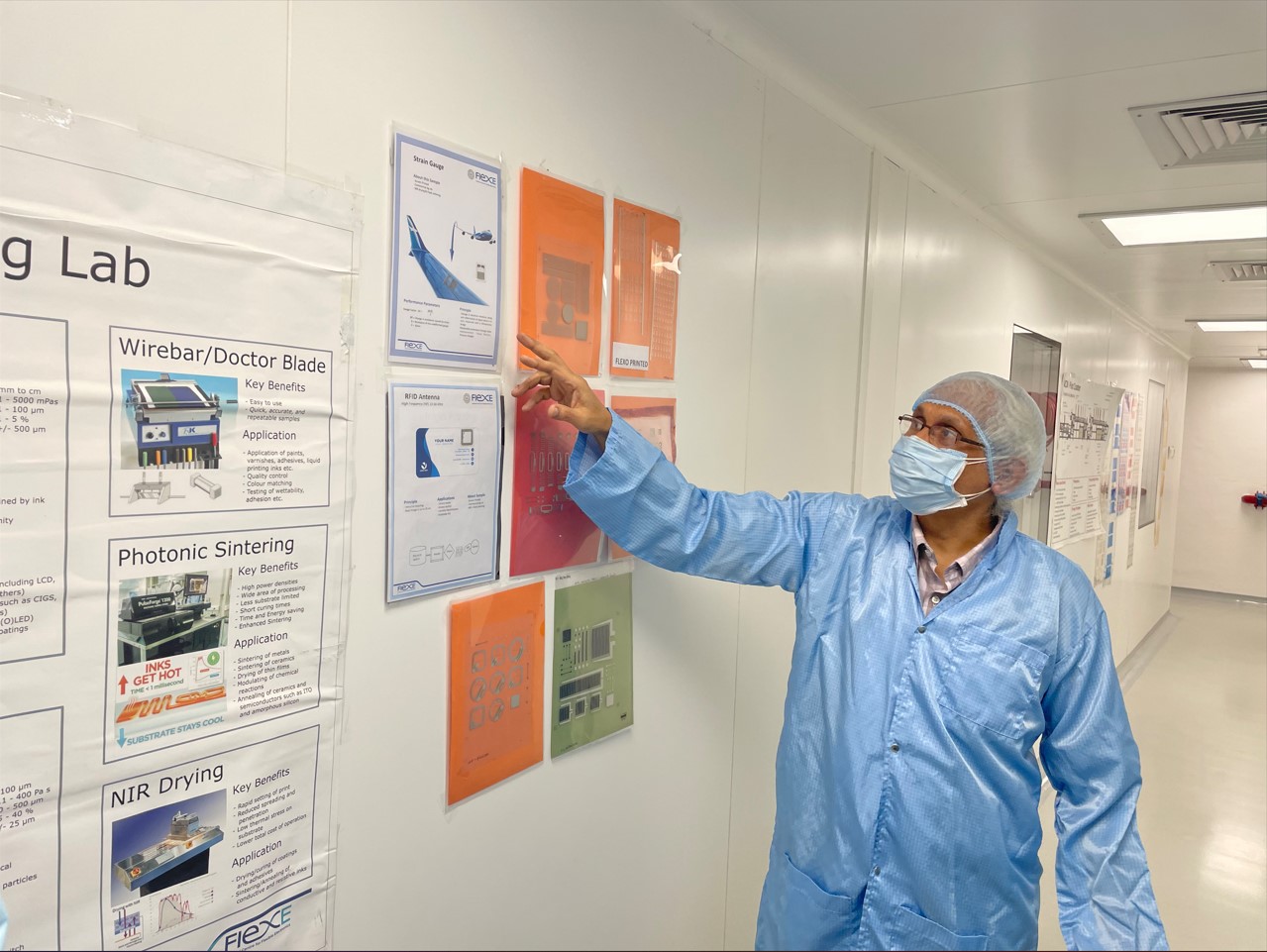
Prof Iyer sharing examples of sheet-to-sheet printed electronics
The second start-up mentored by the ink team led by Prof. Y.N. Mohapatra and Dr Ashish Gupta is called Likhotronics. This start-up has developed pens that have a variety of electrically-conductive inks which are supplied as a do-it-yourself (DIY) kit. By drawing lines with these pens on paper, one can create functioning electronic circuits which could be used to help children learn concepts in electronics. This is expected to have an impact on education – teaching and examining electrical circuit concepts – in the coming years.
The strength of the centre is in its ability to reach out to the industry and work with them in developing many relevant solutions. This process is ably supported by the COO Dr Sudheer Kumar along with the individual faculty members and other team members.
The Flex-E Centre is a multidisciplinary centre institute, where research results from various disciplines (including electronics, materials, chemistry, physics, chemical engineering, and bio-engineering) are brought together for addressing the needs of society. Such a dynamic centre of excellence, with cutting-edge innovation and technological advancements, is a matter of immense pride not just for our Institute but for our nation as well. Keep an eye out for novel ideas and technologies from this engineering and science centre!
We thank Prof. Sundar Kumar Iyer for his great zeal and support in helping us write this article.
Written
by: Khush Khandelwal, Rahul Jha, Mridul Pandey, Zainab Fatima
Edited
by: Sanika Gumaste, S. Pradeep
Vox
Populi, September 2022,
https://voxiitk.com/flex-e-centre-intersecting-engineering-research-and-entrepreneurship/
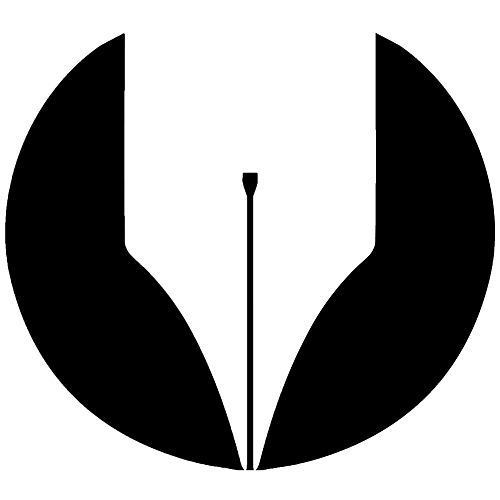
Vox Populi is the student media body of IIT Kanpur. We aim to be the voice of the campus community and act as a bridge between faculty, students, alumni, and other stakeholders of IIT Kanpur.
175
Our Bits of That IITK
Four years ago, a few alumni created the Facebook group “This Bit of That IITK” with the intent of preserving IITK memorabilia, while reliving the cherished memories of our formative years. Today, this community has grown to be over 5,000 strong, with the largest collection of current and historical IITK pictures, memorabilia, and anecdotes available anywhere.
We welcome new members to this group: students, alumni, faculty, and staff, and all others with valid IITK connections, and we do ask that you respond to the three screening questions so that we can validate your membership.
Here are some bits of IITK that we’d love to share…
Where the Mind is Without Fear

A view of the campus from 1967, as originally envisioned by our founders. When solid boundary walls weren't a necessity to define a hostel and movement was unrestricted. Nothing came in between the open, serene IITK campus, bubbling with activity, and the clear skyline, personifying the words of Gurudev Rabindranath Tagore:
Where
the world has not been broken up into fragments
By
narrow domestic walls
And
the clear stream of reason has not lost its way
Into
the dreary desert sand of dead habit…
Credits:
Text adapted from a Vox Populi Nostalgia Sunday post by Soumyadeep
Datta and Aditya Sonthalia; Picture clicked by Gyan Mehta (MSc
Physics, 1968) from the top of the Hall III water tank, 1967
176
Witnessing History
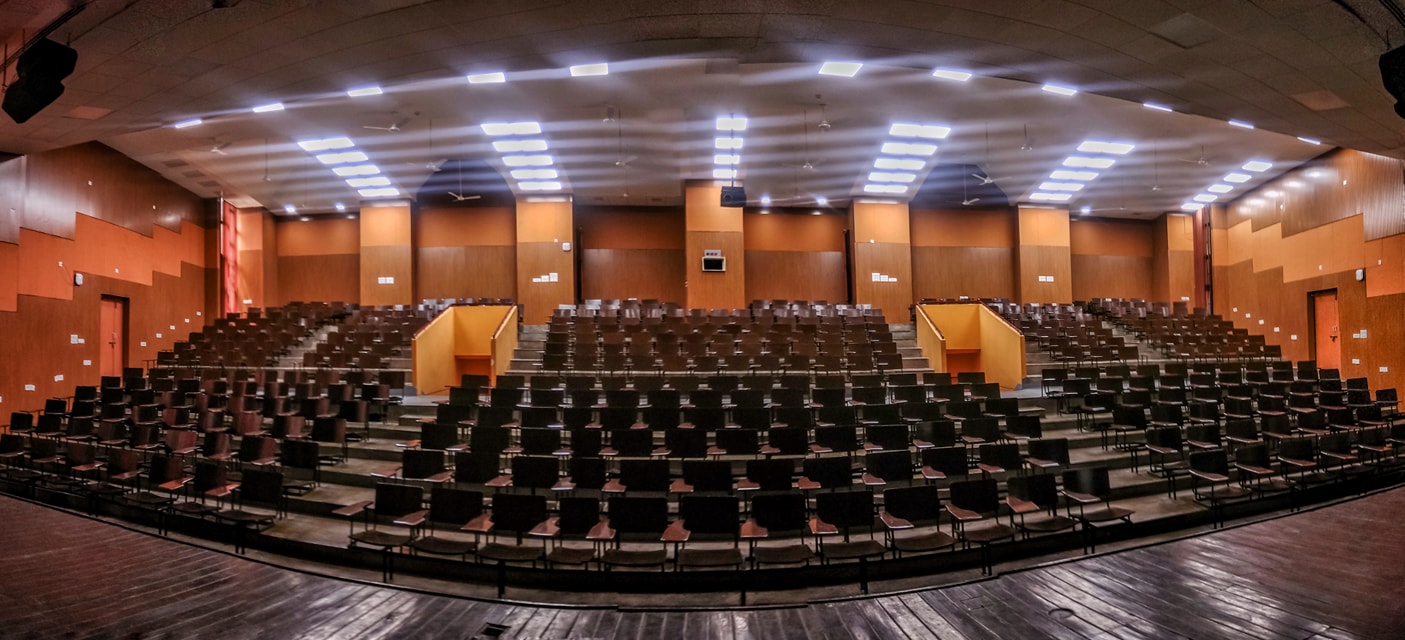
L-7: These seats have witnessed more IITK history than any other location on campus. From orientations to commencements, with classes, exams, movies, concerts, and everything else in between! This view has changed over the years with the stairwells replaced with seats to accommodate larger batch sizes. This is how it looks today after the restorations completed a few years ago.
Picture shared by Krishnendu Paul (Research Scholar, Earth Science)
Those Technical Arts (TA) and Engineering Science (ESc) Classes…
The TA and ESc courses did lead to interesting events!
1. A standard lab session in the TA course on surveying was to find the height of the Faculty Building. My lab group was so cock-sure that they had done everything right that nobody checked to verify the physical feasibility of the answer! ... Turned out that we had calculated the Faculty Building to be just a few feet shy of the Eiffel Tower! We got ribbed about that for the rest of the semester!
2. I never learned much about the finer points of the Machines Lab. I was the only non-ME guy in our group of five and was always delegated the important responsibility of getting "ganne ka ras" in a thermos (how else can you keep it cold!) for my lab mates!!
3. ... and then there was the afternoon ESc course which we all hated (hot lecture halls in Kanpur!). Even people who did come would try to sneak out sometimes, especially if they were lucky enough to sit near the rear exits. This would be ok, except once the prof saw a guy leaving and decided to chase him and bring him back. That would have been ok too except that by the time they came back, half the class had bolted from the other rear exit!
Sanjay Bose, (BT, EE, 1971-76, Faculty EE 1982-2003, currently Professor EE, IIT Guwahati)
177
Leopard on the Run!
A leopard has been spotted on campus. This animal is suspected to be hiding in the dense green cover in the area around the IWD office, helicopter lab, and the new type 3 area. The Institute security force has been deployed to monitor its movement, and the forest department has been requested to take appropriate action. Residents on campus, particularly children, are advised to remain vigilant and cautious until further notice.
This is an update on the leopard activity on campus. The combing operation is still ongoing, and a combined team of forest officials and institute security has located the animal. Last night, the animal expanded its movement zone and was tracked around the shopping centre and Park 67. The current location is thought to be near the green cover surrounding the gas godown (lane 31). The security team is on high alert and continues tracking the animal for its eventual capture. Residents are advised to be vigilant and cautious.
This is an update on the leopard movement on campus. A high-level team led by Kanpur's chief conservator officer and trained Zoo officials are camping on campus to capture the animal. The team has tried a variety of options, including a cage with prey, night vision cameras and drones for tracking, and attempted to tranquillise the animal on sight. The animal hides among the dense vegetation, evading capture, but best efforts are in place. Given the movement of the animal, particularly at night, campus residents are advised to be vigilant and cautious and to limit movement at night.
S. Ganesh, Deputy Director, IITK, October 2022
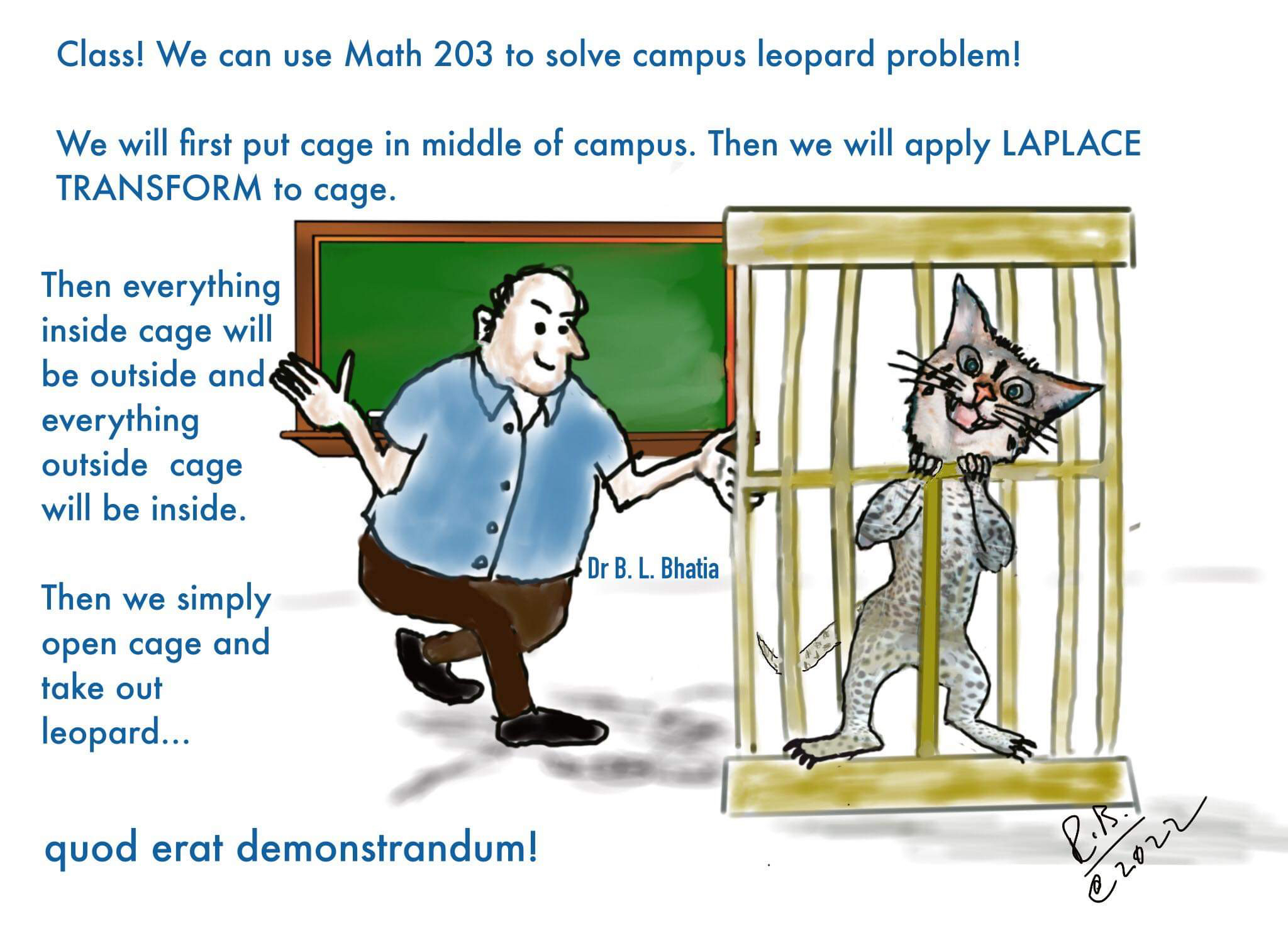
Shared by Raman Bhatia (BT, ME, 1977-82)
To our knowledge, the leopard has left the campus of its own accord. It was spotted at the Sugar Institute across GT Road, leaving nearby residents with some sleepless nights. As of Nov 17, 2022, there had been no new evidence of its presence on campus for ten days.
178
From Dusk to Dawn
Starry, starry night
Paint your palette blue and gray
Look
out on a summer's day
With eyes that know the darkness in my
soul…
'Vincent’ by Don McLean, 1971
Magic commences on campus during that brief period of light at dusk, and before night falls. It's the ‘blue hour’, when the sky is deep blue, but not dark. Stars are struggling to shine, and the day’s dust is settling. It is too dark to see the ball on the football field, but too early to make your way to the library. It's the time when the dreamy ones return to their rooms after enjoying a splendid sunset, and turn on the lights.
As the darkness of the night follows, somebody strums their guitar in the quad, the cigarette glows and smoke rises at the end of a dark corridor. Plans are made for the night, somebody has a quiz, someone must write the lab report, yet another has to fill in the application for admissions, while some settle for a long session of bridge.
Soon, it is dark, and dinner is done. Some head out for a night at the library, out of the sweltering heat, others have booked sessions at the computer centre. This guy has to take readings through the night on a long experiment, while a few gather in the television centre to film a new production which nobody will see.
And so moves on the night, endless cups of tea and coffee, bulling about nothing in particular, till they start stumbling out one by one, overtaken by fatigue of many long nights with few snatches of sleep. Others trudge back as the library shuts its doors, meeting triumphant returnees from the CC who have concluded a tough assignment.
While some are waking up at the dawn of a new day, with a cold shower and ready cheat sheets before the mess opens for breakfast, others are calling it a night of bridge, hoping to catch the fag end of breakfast timings. Still others are finishing their endless bull session, starting to think about the quiz after dawn.
And while the campus is still enveloped in misty darkness, the sky is lighting up in the east. During winters this is time for the densest fog, as mists blow out of the sleepy canal, and stick like ghostly tendrils to the dark undergrowth. In summers the sky turns a quick orange, as the sun peeps over the horizon, dawning another day. And during the monsoons the grey sky continues to drip for dawns on end.
There stands a lone enthusiast on top of the FB, aiming his camera as the rays of the sun hit the sixth floor for the one elusive, inspirational, brilliant shot.
This narrative describes life on the campus in the early 1980s. Perhaps, some elements remain true today.
Anurag Dikshit (BT, ME, 1978-83)
179

The Fountains of Success at the Kelkar Library. Picture Credit: Prof Praveen Kulshreshtha (Dept of Economics).

House of Reflections: The quiet fountains on a more typical evening. Picture Credit: Shakti Chaturvedi (Research Scholar, IME)
180

Starry, starry night… trails across the LHC. Clicked by Krishnendu Paul (Research Scholar, Earth Sciences)

The sun sets over Western Labs, seen from the Sixth Floor of the FB. Taken by Himadri Roy (Research Scholar, Physics)
181

Light filters through the windows of the Rajeev Motwani Building on this October evening. Picture Credit: Archit Gupta (MT, CSE, 2021-23)

Late at night, on the way home. On the road between H8 and H9. Clicked by Vishal Narnaulia (Research Scholar, Physics)
182

View across the rooftop… from Hall 8. Clicked by Rajib Mandal (Research Scholar, Chemistry)

And another starry night… this one from the roof of Hall 11. By Himanshu Singh Gehlot (MT, Earth Sciences, 2018-20)
183

Fun and play… the SAC tower, seen during campus festival celebrations. Picture Credit: Animesh Singh (BT, CE 2019-23)

And the tower, captured against the setting sun. Picture Credit: Granth Choudhary (BT, EE 2020-24)
184

L-7 takes a back seat! Telecast of an India-Pakistan T20 game in progress at the OAT. Picture Credit Arush Rai (BT, CE, 2020-24)

The sun sets on the Hockey Field, located opposite the Pool and Hall 4. Picture Credit: Shashank Chaudhary (M Design 2018-20)
185

Frolicking in the Sunset at the Oxidation Pond. Picture Credit: Sandeep Yadav (Research Scholar, Chemistry)

Dusk of Peace at the Oxidation Pond. Picture Credit: Prof Praveen Kulshreshtha (Dept of Economics).
186

Reflections of the PKK Library in still water. Picture Credit: Aman Kumar Singh (BT, CE, 2020-24)
The pictures for this story were contributed by members of the FaceBook group ‘This Bit of That IITK’.
Cover Pictures:
Front Top: A night view of ‘the Crow’. Prof. Praveen Kulshreshtha (Dept of Economics), Feb 2022. Bottom: The LHC on a rainy evening, Shakti Chaturvedi (Research Scholar, IME), Sept 2022.
Back: As the Crow Flies…
A lone bird circles above the Faculty Building, looking down on the campus below. The view from the spiral staircase, clicked by Chidanand Jadar (Research Scholar, CE), July 2022
187

Cover Design: Outreach Cell, IITK